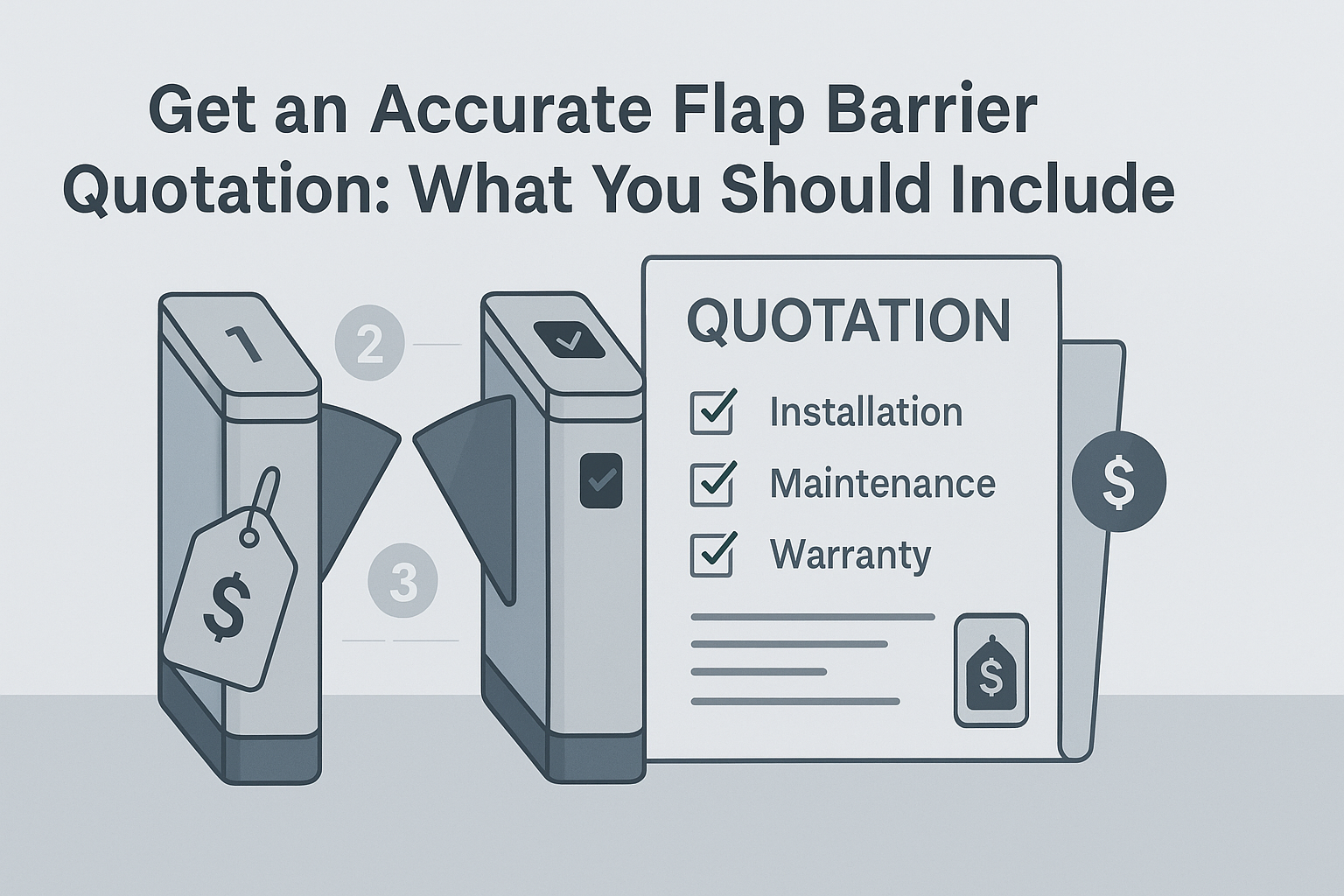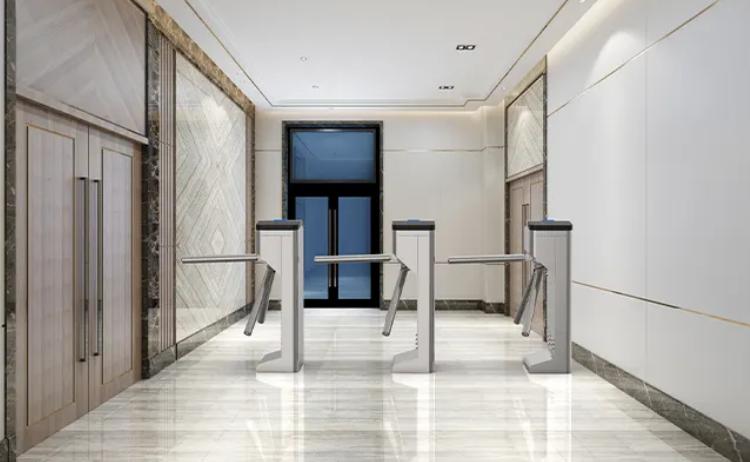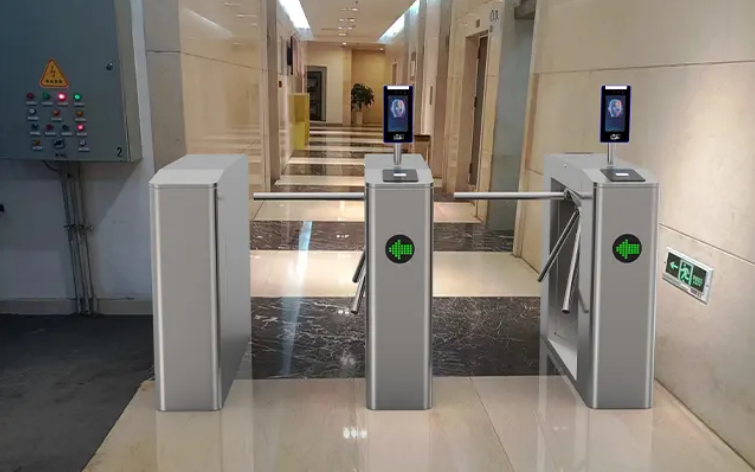Get an Accurate Flap Barrier Quotation: What You Should Include


A security manager sits at their desk, sifting through a set of quotation emails for flap barriers. Some responses are vague, listing only model numbers and “base pricing.” Others are bloated with expensive extras that were never requested. A few have unclear timelines or incomplete installation details. Instead of gaining clarity, the manager is left with more questions than answers—and a ticking clock from leadership asking when the system will be installed.
It’s a familiar frustration for anyone handling access control procurement. Getting an accurate flap barrier quotation isn’t as simple as sending a quick request to a vendor. Too often, quote requests lack vital site details, technical specs, or integration requirements. The result? Inconsistent pricing, unexpected add-ons, project delays, and sometimes non-compliance with building or safety regulations.
Accurate quotations aren’t built on guesswork—they rely on precise and thorough input from the buyer. Vendors need this context to tailor their offers effectively. When quote requests are vague, vendors have to pad estimates to protect themselves, or worse, underquote and revise pricing midway. Either scenario leaves the buyer at risk.
But when buyers prepare properly, the process transforms. Clear, detailed quote requests invite faster, more transparent responses. You reduce confusion, prevent budget shocks, and build trust with suppliers. This article breaks down exactly what you need to include in a request to receive a complete and accurate flap barrier quotation—ensuring your next procurement runs smoothly from inquiry to install.
What Is the Importance of a Complete Quote Request
The key to unlocking an accurate flap barrier quotation is information—clear, complete, and relevant. Vendors don’t operate in a vacuum. To provide realistic pricing, they need to understand not just the product specs, but also the environment where the barrier will be installed, the volume of usage, and how it will integrate with other systems.
Think of the quotation process like designing a tailored suit. If you don’t provide the right measurements, materials, or design preferences, the result will be ill-fitting. The same applies to a quote request for access control equipment. Vendors need your “measurements”—like installation conditions, access control infrastructure, and desired performance outcomes—to customize pricing that reflects your actual needs.
There’s also the matter of scope creep. Incomplete quote requests often omit critical items like emergency features or integration support. These get tacked on later, surprising finance teams and delaying sign-off. Worse, buyers might receive a lowball estimate that doesn’t cover training, delivery, or commissioning, leading to budget fights down the road.
The buyer’s responsibility is to set the process up for success. That means gathering all necessary data in advance, confirming internal requirements, and presenting it clearly. In doing so, buyers make it easier for vendors to respond quickly—and accurately. And in a field where timelines and compliance are critical, that precision pays off.
Step One – Know Your Site Specifications in Detail
Site specifications are the foundation of any reliable flap barrier quotation. Without them, vendors are left to guess how their systems will fit or perform in your building. These details not only affect pricing but determine the entire scope of work—dimensions, power requirements, mounting surfaces, and even safety measures.
Start by measuring the physical entrance where the barrier will be installed. Include width, ceiling height (if mounting equipment above), and distance to nearby walls or objects. Clarify whether the entrance is indoors or exposed to weather, as this influences the type of materials and protection needed. Will this barrier control access to a lobby, restricted hallway, or external gate?
Next, provide flooring details. Is it tile, concrete, or carpeted? Some installations require customized mounting solutions or additional stabilization based on floor type. This can change both the hardware and the labor cost. If the entrance is sloped or uneven, note that as well—it can affect sensor calibration and safety alignment.
Beyond structure, consider environment. Is the site in a high-dust area like a warehouse? A high-humidity environment like a pool or locker facility? Will cleaning crews use industrial chemicals nearby? These conditions guide the vendor’s recommendation on material finishes and IP ratings.
Compliance matters too. Are there local codes or building standards the barrier must meet? Does the building require ADA-compliant clearances or fire system integration? Each of these factors changes how the barrier will be configured and priced.
When buyers deliver a full site profile, vendors can assess real-world fit, avoid misquoted specs, and flag installation challenges early. This saves time later—and ensures the quote reflects actual project demands.
Step Two – Clarify Throughput and Usage Requirements
A flap barrier system isn’t just a piece of hardware—it’s part of the flow of your space. That’s why understanding throughput requirements is essential. It informs the type of mechanism, number of lanes, speed configuration, and sensor sensitivity. These directly influence the final quote.
Start by calculating the average number of users per day. Then, identify peak usage periods—say, morning shift changes or lunchtime in a corporate office. This helps vendors recommend models that meet performance needs without overspecifying for low-traffic use.
Decide whether you need one lane or multiple. Multi-lane setups aren’t just more expensive—they also require more precise layout planning. Vendors will need CAD files or dimension drawings to estimate labor and equipment accurately. They’ll also recommend synchronized logic controls if several lanes are used side by side.
Speed is another critical factor. Some environments demand rapid processing—think metro stations or airport gates—while others prioritize smooth, deliberate access, such as museums or galleries. Let your vendor know if speed is a priority over noise level or mechanical durability.
Keep in mind that certain barrier configurations (like narrow flaps or transparent wings) are better suited for low to medium traffic, while more robust versions handle constant cycling more reliably. Matching throughput needs with the right model avoids overbuying—and underperformance.
By clearly defining your daily traffic and expectations, you eliminate guesswork from the quote and ensure the selected product actually suits your operations.
Step Three – Define Your Access Control Integration Points
Many quote requests ignore the most technical—but most important—question vendors must answer: how will this flap barrier integrate with your existing access control setup?
Today’s barriers are not standalone. They sync with badge readers, biometric scanners, employee databases, fire systems, and central monitoring dashboards. If the vendor doesn’t know what systems they’re connecting to, they can’t quote accurately.
So, spell it out. Are you using RFID cards, QR codes, facial recognition, or PIN keypads? Will the barrier need to support dual authentication (e.g., badge + fingerprint)? Each of these changes the internal logic board and cabling required—affecting both price and complexity.
Provide the name and model of your access control software, whether it’s proprietary or off-the-shelf. Detail communication protocols like Wiegand, RS485, or TCP/IP. If your IT team has documentation or diagrams, include them in the quote request. If integration help is needed, ask the vendor whether they provide onsite IT configuration support and what that costs.
Also, mention any planned upgrades. If you’re currently using RFID but plan to shift to biometric within a year, vendors can advise on modular options that make future expansion easier.
Don’t assume vendors will figure this out later. Integration is one of the top causes of post-sale cost increases. Accurate, upfront information results in tailored recommendations—and avoids messy surprises once installation begins.
Step Four – Don’t Overlook Physical and Aesthetic Preferences
While functionality and integration are central to a flap barrier quotation, physical appearance and finish can be just as critical—especially in environments where design continuity and first impressions matter. Unfortunately, these preferences are often left out of initial quote requests, leading to price revisions or unsuitable selections that disrupt a facility’s visual flow.
When preparing your request, identify whether the flap barrier will be installed in a high-profile, design-sensitive area. Locations like hotel lobbies, corporate reception areas, or public museums often require sleek, minimalistic barriers that align with interior themes. Share photographs, finish samples, or design guidelines that reflect the visual tone of the space. Most vendors offer multiple finishes—brushed stainless steel, powder-coated colors, tempered glass panels, or acrylic inserts. Some of these incur extra charges, which should be included in the quote upfront.
Flap material matters too. Will the wings be transparent polycarbonate, frosted acrylic, or solid panels? Each type carries different pricing and maintenance considerations. Solid flaps may look more robust, but transparent wings reduce visual intrusion and help maintain open sightlines. Aesthetics also influence how barriers are perceived by visitors—some finishes feel more welcoming, while others convey heightened security.
Don’t forget about accessibility features. Do you need wider lanes for wheelchair users or deliveries? Should visual indicators like LED lights be discreet or prominent? What about anti-tamper protection or base covers to hide wiring? All these choices affect both appearance and functionality—and every one impacts the quote.
Buyers who skip aesthetic details often face unexpected add-ons later. Being upfront about how the barrier should look, feel, and perform ensures the vendor includes the right materials and design elements in the initial quote, not as costly revisions down the line.
Step Five – Emergency and Safety Features Matter
It’s not enough for a flap barrier to control access—it also has to respond correctly during emergencies. Whether it’s a power failure, fire alarm, or safety breach, buyers need to consider how the system behaves under stress. But in many quote requests, these features are poorly defined or completely omitted, leading to incomplete pricing and compliance gaps.
Emergency requirements vary widely by site. For example, a hospital or government building may require automatic release in the event of a fire, while a private data center may demand failsafe locking during a breach. Vendors need to know which behavior your location requires, and which protocols must be triggered. These configurations often require specialized relays or software logic—and they affect both hardware costs and control unit programming.
Battery backup is another overlooked feature. Will the barrier operate during a power outage? If so, for how long? Some vendors include an onboard power backup system, while others treat it as an optional upgrade. You need to be clear whether continuity is essential, and for what duration. This could change your quote significantly.
Compliance issues also play a role. In many regions, access points must be ADA-compliant, with visual and audible alerts for users with disabilities. If your organization must meet these standards, include them in the quotation request. Flap barriers can be configured with flashing LEDs, spoken prompts, or tactile response surfaces—but not all models offer this out of the box.
Lastly, if you’re integrating with a building fire system or emergency panel, your vendor will need wiring diagrams and communication protocols. This allows them to quote the right relay modules and avoid underestimating the labor cost during commissioning.
Step Six – Include Delivery and Timeline Constraints
Many buyers assume delivery timelines and logistics are handled separately from the quote—but they’re not. Delivery, staging, and installation plans significantly influence both cost and vendor selection. That’s why you need to include any logistical or timing requirements in your flap barrier quotation request.
Start with your preferred delivery window. If the system must be delivered within a specific timeframe—such as before an opening event or construction milestone—make that clear. Lead times for flap barriers can vary widely depending on customization, manufacturing origin, and shipping logistics. Some systems may take eight weeks or more. Others can ship in two weeks but incur express freight fees.
Next, outline the on-site conditions. Is there an elevator for equipment delivery? Will installation need to happen at night or on weekends to avoid disrupting operations? Are there union labor requirements or site access restrictions? All these factors affect how vendors quote installation services—or whether they can perform them at all.
Buyers should also clarify who will install the system. Some vendors include installation in the quote. Others expect buyers to handle that separately. If you need the vendor to install, say so in your request and provide layout plans or architectural drawings. If you’re working with a general contractor, coordinate roles to avoid overlap or delays.
Finally, outline your go-live deadline. When does the barrier need to be operational? Is there buffer time for testing and staff training? Clear timelines help vendors align manufacturing, shipping, and technician schedules—and include those costs accurately in their proposal.
Skipping these logistical details often leads to rushed schedules, rushed installs, or project overruns. Including them upfront ensures your quote matches your actual deployment plan, not a vendor’s default assumptions.
Step Seven – Understand the Pricing Structure
Getting a price is not the same as understanding a price. Many buyers receive a flap barrier quotation that lists a base unit price but leaves them guessing about what’s included—and what’s not. Without clear definitions, even a “low” quote can hide major expenses. That’s why buyers must push for full visibility into pricing structure before accepting any proposal.
First, ask vendors to itemize everything. What’s included in the base price? Does it cover mounting hardware, wiring kits, power supply units, and control boards? Does it include integration support with your access system? What about installation labor or commissioning? Vendors that bundle everything into one figure may seem transparent, but it makes it harder to compare proposals fairly.
Then look at optional add-ons. These might include visual indicators, biometric reader mounts, battery backups, networked control panels, or extended warranties. Sometimes, what one vendor includes by default, another lists as an extra. Misinterpreting these lists leads to poor comparison and procurement errors.
Check whether software licenses are perpetual or subscription-based. A lower upfront cost may be offset by recurring license fees later. Also, confirm if firmware upgrades or remote diagnostics are included for the first year—or require separate contracts.
Training is another hidden variable. Does the quote cover operator training? What about technician certification for your facilities team? If not, request pricing for those services explicitly.
For reference, you can explore how vendors break down these factors in detail using this pricing factors guide. It helps compare apples to apples—ensuring that your quote reflects both your needs and your budget constraints.
Step Eight – Specify Post-Sale Support Expectations
Procurement doesn’t end at delivery—and neither should your quote. Ongoing support, maintenance, and upgrade access are essential parts of owning a flap barrier system. Yet many buyers fail to define these expectations when requesting quotes, leading to long-term frustrations with unresponsive vendors or unclear service terms.
When sending a quote request, state your desired service-level agreement (SLA). How quickly should the vendor respond to faults? Are you expecting same-day technician dispatch or remote diagnostics within two hours? Different vendors offer vastly different SLA tiers, and each comes with a different cost. These must be quoted clearly.
Also, ask about availability of spare parts. Is the vendor offering full parts support for five years? Will parts be stocked locally, or must they be imported with lead times? Some vendors offer extended parts kits as part of the sale, allowing your maintenance team to handle minor repairs quickly.
If you’re operating in multiple locations, check whether the vendor offers regional support coverage. Can they deploy technicians across sites? Or are they limited to major urban centers? If you’re working in remote areas, support limitations should be priced into your maintenance plan or service fees.
Don’t ignore communication. Ask vendors to outline how support issues will be reported and tracked. Will you use a dedicated portal? A hotline? Is there an escalation path for unresolved issues? You can also assess a vendor’s reputation for service by performing a formal vendor check and contacting past clients.
Defining post-sale expectations before receiving a quote helps the vendor plan—and quote—for the real cost of long-term service. It also signals professionalism, which tends to improve vendor engagement quality.
Step Nine – Validate Vendor Quality Before the Quote
Even the most detailed flap barrier quotation becomes worthless if it comes from a vendor that can’t deliver on their promises. That’s why due diligence isn’t something you do after receiving the quote—it should begin before the request is even sent.
A strong first step is conducting a vendor background check. This doesn’t require expensive tools—just a few well-placed questions and a review of available data. Look into the vendor’s years in operation, installation case studies, and client portfolio. Ask for references specifically related to similar environments or project sizes. If you’re sourcing for a public transit hub, don’t settle for references from small office lobbies.
Request documentation such as ISO certifications, product testing results, and installation manuals. Vendors that can’t—or won’t—supply this upfront should raise concerns. Their lack of transparency at the quoting stage often reflects broader issues with support or post-sale service.
Pay close attention to how they respond to your quote request. Do they follow up with clarifying questions? Do they confirm understanding of site specifics and integration needs? Vendors who ask good questions often deliver good results. Those who send vague, template-style quotes without customization are less likely to support you properly during implementation.
You can also perform a formal vendor check using tools that aggregate supplier reputation, performance scores, and dispute history. It’s a small effort that can prevent major problems later.
Validating vendor quality before the quotation ensures you’re not just getting the right price—but that the price is backed by the capability to deliver, support, and scale the solution reliably.
Step Ten – The Impact of a Strong Quote Request on Procurement Success
A strong flap barrier quotation request doesn’t just make the vendor’s job easier—it transforms the entire procurement process. Buyers who provide full details upfront tend to move faster, negotiate smarter, and install smoother. Every step—from vendor selection to contract signing—is simplified when the groundwork is solid.
Clear requests reduce back-and-forth emails, allowing vendors to respond with tailored, comprehensive quotes. This speeds up your decision-making process and increases the likelihood of meeting your deployment timeline. When time is money, that’s a huge advantage.
Detailed requests also empower procurement teams to evaluate proposals side-by-side with confidence. You can compare not just prices, but included services, compliance coverage, warranty terms, and integration readiness. This kind of clarity helps justify procurement decisions to upper management and reduces second-guessing after contracts are signed.
Perhaps most importantly, detailed quote requests build stronger vendor relationships. When suppliers see that you’re organized, precise, and serious, they prioritize your project. They’re more likely to assign top technical staff, fast-track production, and flag risks early—because they see you as a reliable partner, not a risky client.
To make the most of your investment, leverage expert procurement tips. These resources provide best practices for managing vendor relationships, setting expectations, and aligning technical goals across stakeholders.
Ultimately, the quality of your quote request sets the tone for the entire project. Get it right, and the rest of the process tends to follow smoothly.
Industry Guidance and Quotation Best Practices
Experienced procurement professionals rely on tested strategies and industry guidelines to refine their quote requests. Fortunately, there are several excellent resources available to help you approach the flap barrier quotation process with greater confidence.
Start with quotation-specific insights from the physical security space. Publications like CSO Online offer practical advice for security managers dealing with hardware procurement, including real-life case studies on pitfalls to avoid and features that often get missed in requests.
On the logistics and supply chain side, the vendor quotes guide from Supply Chain Management Review discusses how vendors interpret quote requests, how they prioritize clients, and what details help accelerate approvals. Understanding this perspective can help buyers tailor their requests for maximum clarity and response quality.
From both resources, the message is clear: completeness equals clarity. The more a vendor understands your goals, constraints, and environment, the better they can serve you—not just in pricing but in aligning their team, tooling, and timelines with yours.
If you’re unsure where to start, begin by analyzing past procurement projects. Identify which quote requests led to delays or surprises. Then reverse-engineer what information was missing and use that to inform your next request. Over time, you’ll build internal best practices tailored to your specific facilities and IT landscape.
Professionally managed quote requests aren’t just about saving money—they’re about setting up your entire access control strategy for long-term success.
Checklist: What to Include in a Flap Barrier Quotation Request
- Complete Site Dimensions: Entrance width, ceiling height, flooring type, and environmental conditions.
- Traffic Volume: Average daily users and peak times to determine throughput needs.
- Access Control Integration: List of existing systems, protocols, and future upgrades.
- Barrier Design Preferences: Material finishes, flap style, indicator types, and accessibility requirements.
- Safety & Emergency Features: Required fail-safe modes, backup systems, ADA compliance, and fire system triggers.
- Delivery & Installation Plans: Timeline constraints, staging needs, access restrictions, and go-live goals.
- Itemized Pricing Requests: Request clear breakdowns of hardware, labor, support, licenses, and warranties.
- Post-Sale Support Terms: SLA expectations, spare parts plans, response times, and communication process.
- Vendor Documentation: Certifications, case studies, reference projects, and technical datasheets.
- Contact Information: Assign a primary point of contact for follow-ups, clarifications, and scheduling.
FAQs
Q1: Why do flap barrier quotations vary so much between vendors?
Because vendors interpret vague requests differently. Without full site, integration, and feature details, they rely on assumptions—leading to over- or under-pricing.
Q2: Can I use a template quote request for every project?
Not effectively. Each project has unique site constraints, traffic volumes, and integration needs. A one-size-fits-all template often leads to missed requirements and incomplete pricing.
Q3: How soon should I expect a quote after submitting a request?
If your request is complete and well-structured, many vendors respond within 3–5 business days. Complex projects with custom finishes or integrations may take longer.
Q4: Is it okay to send the same quote request to multiple vendors?
Yes, but make sure it’s detailed and consistent across all vendors. This ensures a fair comparison and reduces follow-up confusion.
Q5: What’s the best way to validate a vendor before requesting a quote?
Use a combination of references, certifications, and a vendor check. Review their past performance and ask for case studies aligned with your use case.












